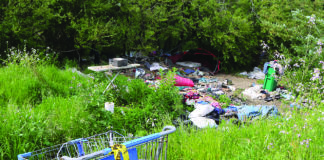
SANTA CRUZ COUNTY—A little more than a week ago, a series of weather calamities began that assailed the Central Coast, bringing torrential rain that flooded several neighborhoods and destroyed multiple homes.
In addition, a coastal swell decimated the wharf at Seacliff State Beach and rendered much of Capitola’s beachside village uninhabitable.
On Tuesday, the Santa Cruz County Board of Supervisors unanimously ratified an emergency declaration that will allow the county to receive disaster assistance even as residents and business owners simultaneously dig out and prepare for more storms predicted to be coming.
That includes another coastal swell expected to be more powerful than the one that hit on Thursday, California Gov. Gavin Newsom told a group of reporters gathered in Capitola Tuesday.
The Supervisors’ declaration followed similar ones made by the cities of Capitola and Santa Cruz last week.
Dave Reid, who runs Santa Cruz County’s Office of Response, Recovery & Resilience, called the storm damage so far “unprecedented,” with rains that flooded the San Lorenzo River, as well as Soquel Creek for the first time in more than 40 years.
County officials have so far responded to mudslides in the Santa Cruz Mountains that pulverized homes and vehicles, and caused an estimated $21 million in damage to 27 roadways. A total of 16 parks and three coastal sites sustained $6.8 million in damages, while the San Lorenzo Valley Water District saw $1.2 million.
Roughly 150 people were staying in a temporary evacuation center at the Santa Cruz County Fairgrounds on Monday night, one of eight shelters set up for evacuees.
Still undetermined is the financial toll the storms took on the cities, Reid says.
Some 45 roads were closed during the storms, including Redwood Road that collapsed and trapped residents, says Public Works Director Matt Machado.
Crews have been working nonstop since New Year’s Eve to clear fallen trees, in addition to maintaining drainages, sanitation systems and maintaining the County’s infrastructure, Machado says. This includes 11 emergency contractors and crews conducting levee inspections 24 hours a day.
Building inspectors have so far issued 132 yellow tags at damaged homes, meaning they have limited use but residents can still stay. They have also issued eight red tags, meaning the structures are uninhabitable. Both of these numbers are expected to increase.
Machado says that the County will have to choose which projects get done first.
“The magnitude of them is such that we won’t be able to fix them all at once, and so similar to 2017 storms we have to prioritize and do the worst first for various reasons,” he says.
A rain gauge recorded 23 inches in 10 days, a number Reid says does not yet match those of 2017, when the same gauge showed more than 50 inches in six weeks. With the streams and rivers already full and the ground saturated, even smaller storms can have a bigger impact, he says.
“This is unprecedented, but not unfamiliar territory, and we’re not out of the woods,” Reid says. “And we’re certainly not setting up 2023 to be better than 2017, it certainly could be worse.”













Look at that coward Newsolini…
The state is broke and now all the storm damage. My suggestion buy a U Haul franchise
Our State has the following budget. How can Watsonville get money from the state for flood control until the federal grant kicks in and will the cost go up since all the damage to the levee that has occurred during this storm?
$297 BILLION: Balanced Budget
$223.6 BILLION: General Fund
$22.5 BILLION: SHORTFALL